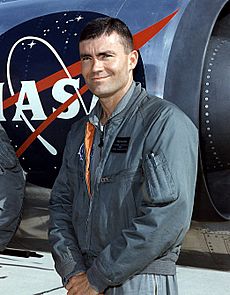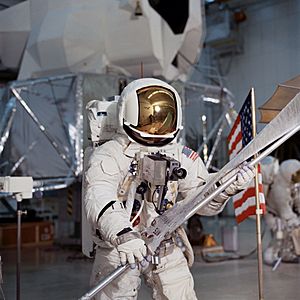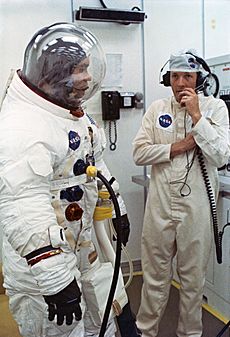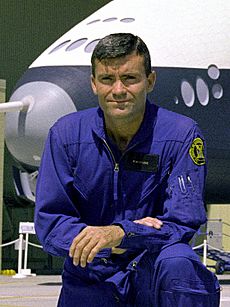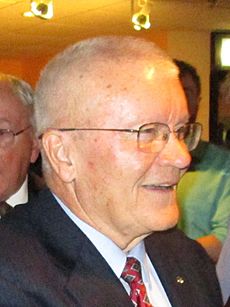Fred Haise facts for kids
Quick facts for kids
Fred Haise
|
|
|---|---|
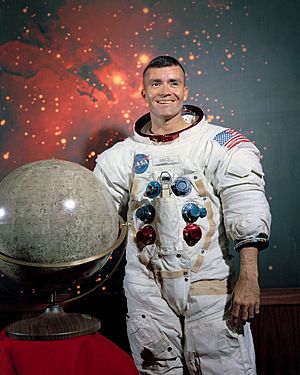
Haise in 1969
|
|
| Born |
Fred Wallace Haise Jr.
November 14, 1933 Biloxi, Mississippi, U.S.
|
| Awards | Presidential Medal of Freedom NASA Distinguished Service Medal |
| Space career | |
| NASA astronaut | |
| Rank | Captain, USMC (1954–1957) Captain, USAF (1957–1963) |
|
Time in space
|
5d 22h 54m |
| Selection | NASA Group 5 (1966) |
| Missions |
|
|
Mission insignia
|
  |
| Retirement | June 29, 1979 |
Fred Wallace Haise Jr. (pronounced HAYZ; born November 14, 1933) is an American former NASA astronaut. He was also an engineer, a fighter pilot for the U.S. Marine Corps and U.S. Air Force, and a test pilot.
Fred Haise is one of 24 people who have flown to the Moon. He was the Lunar Module pilot on the famous Apollo 13 mission. He was supposed to be the sixth person to walk on the Moon, but the Apollo 13 landing was canceled during the trip.
After his space flight, Haise flew five Space Shuttle test flights in 1977. He retired from NASA in 1979.
Contents
Early Life and Military Service
Fred Wallace Haise Jr. was born on November 14, 1933. He grew up in Biloxi, Mississippi. When he was young, his family moved around a bit because his father joined the U.S. Navy during World War II.
Fred graduated from Biloxi High School in 1950. He then attended Perkinston Junior College on a journalism scholarship. He also played on the baseball team. After graduating in 1952, he joined the Naval Aviation Cadet Program. He trained to become a pilot and finished his flight training in 1954.
He served as a U.S. Marine Corps fighter pilot. He flew different types of fighter jets. Later, he also worked as a flight instructor for the U.S. Navy. Fred Haise has flown for a total of 9,300 hours, with 6,200 hours in jets. This shows how much experience he had as a pilot!
After his military service, Fred went back to school. He earned a degree in aeronautical engineering from the University of Oklahoma in 1959. During this time, he also served in the Oklahoma Air National Guard as a fighter pilot. He then started working for the new NASA space agency. He was a research pilot at the Lewis Research Center in Cleveland.
Fred Haise also completed special courses at the U.S. Air Force Aerospace Research Pilot School in 1964. This training helped him become an even better pilot and prepare for space.
NASA Career and Space Missions
In 1966, Fred Haise was chosen as one of 19 new astronauts for NASA. He had already been working with NASA as a research pilot for several years. He was one of the first astronauts in his group to be assigned to a mission. He served as a backup Lunar Module Pilot for both Apollo 8 and Apollo 11. This meant he trained to be ready if the main pilot couldn't fly.
The Apollo 13 Mission

Fred Haise was originally assigned to the Apollo 14 mission. However, his crew was moved to Apollo 13. This happened so that another astronaut, Alan Shepard, could have more training time. So, Fred Haise flew as the Lunar Module Pilot on the Apollo 13 mission in 1970.
Apollo 13 was supposed to land on the Moon, but it had a serious problem. An oxygen tank exploded during the flight. This made it impossible to land on the Moon. The astronauts, Fred Haise, Jim Lovell, and Jack Swigert, had to work together to get back to Earth safely. They used the Lunar Module as a "lifeboat."
Because of how far they traveled from Earth to the Moon, Haise, Lovell, and Swigert hold the record for the farthest distance from Earth ever traveled by humans. Fred Haise and Jack Swigert were the first astronauts from their group to fly in space. During this difficult flight, Fred Haise experienced some pain due to an infection. Despite the challenges, the crew returned safely to Earth.
Fred Haise was supposed to be the sixth person to walk on the Moon during Apollo 13. However, the mission was aborted. Later, Alan Shepard and Edgar Mitchell became the fifth and sixth people to walk on the Moon on Apollo 14. This mission completed the goals that Apollo 13 had planned for the Fra Mauro formation.
Haise also served as a backup commander for Apollo 16. He was also considered to command a future mission, Apollo 19. However, this mission was canceled in 1970 due to budget cuts.
Space Shuttle Test Flights
After his Apollo missions, Fred Haise moved to the Space Shuttle program. In 1977, he took part in the Space Shuttle's Approach and Landing Tests (ALT). These tests happened at Edwards Air Force Base.
Fred Haise was the commander and pilot of the Space Shuttle Enterprise. He flew the Enterprise in free flight after it was released from a special carrier aircraft. He guided it to three successful landings. These tests were very important. They helped prove that the Space Shuttle could fly and land safely. This was a big step toward the success of the Space Shuttle program.
Fred Haise was also assigned to command the second Space Shuttle mission, STS-2A. This mission would have helped boost the Skylab space station to a higher orbit. This would have kept Skylab in space longer for future use. However, there were delays in the Space Shuttle program. Also, Skylab started falling out of orbit faster than expected. Because of this, the mission was canceled. Skylab burned up when it entered Earth's atmosphere in July 1979. The first Space Shuttle did not launch until April 1981.
In June 1979, Fred Haise left NASA. He became a test pilot and executive for a company called Grumman Aerospace Corporation. He worked there until he retired in 1996. He was the only one of the four astronauts who flew the Enterprise landing tests who did not fly into space on the Space Shuttle.
Personal Life
Fred Haise has four children with his first wife, Mary Griffin Grant. They were married in 1954 and divorced in 1978. He married Frances Patt Price in 1979. Frances passed away in February 2022.
In August 1973, Fred Haise was flying an old plane that had been changed to look like a Japanese bomber for a movie. While trying to land, the plane had an engine problem and crashed. Fred Haise was injured in the fire after the crash. He recovered from his injuries.
In 2022, Fred Haise wrote a book about his life and experiences in the Apollo program. The book is called Never Panic Early.
Awards and Honors
Fred Haise has received many awards for his bravery and achievements. Some of his top honors include:
- The Presidential Medal of Freedom
- The NASA Distinguished Service Medal
- The NASA Exceptional Service Medal
He has also been recognized by many organizations:
- He was inducted into the International Space Hall of Fame in 1983.
- He was inducted into the Aerospace Walk of Honor in 1995.
- He was one of 24 Apollo astronauts inducted into the U.S. Astronaut Hall of Fame in 1997.
- In February 2022, a statue of Fred Haise was unveiled in his hometown of Biloxi, Mississippi. He was there for the ceremony and put his handprints in concrete at the base of the statue.
- In September 2023, Fred Haise was inducted into the National Aviation Hall of Fame.
See also
 In Spanish: Fred Haise para niños
In Spanish: Fred Haise para niños


